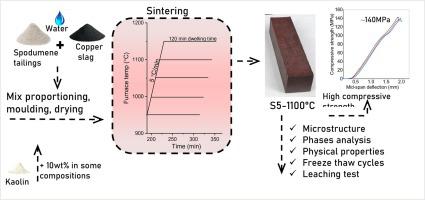当前位置:
X-MOL 学术
›
Miner. Eng.
›
论文详情
Our official English website, www.x-mol.net, welcomes your
feedback! (Note: you will need to create a separate account there.)
Reuse of copper slag in high-strength building ceramics containing spodumene tailings as fluxing agent
Minerals Engineering ( IF 4.9 ) Pub Date : 2020-08-01 , DOI: 10.1016/j.mineng.2020.106448 Patrick N. Lemougna , Juho Yliniemi , Elijah Adesanya , Pekka Tanskanen , Paivo Kinnunen , Juha Roning , Mirja Illikainen
Minerals Engineering ( IF 4.9 ) Pub Date : 2020-08-01 , DOI: 10.1016/j.mineng.2020.106448 Patrick N. Lemougna , Juho Yliniemi , Elijah Adesanya , Pekka Tanskanen , Paivo Kinnunen , Juha Roning , Mirja Illikainen

|
Abstract The recycling of industrial side streams is of interest for a sustainable use of resources and from an environmental perspective. This paper deals with the reuse of copper slag and spodumene tailings in the development of ceramic materials for potential application in construction. Copper slag included fayalite and magnetite as crystalline phases while spodumene tailings (quartz-felspar sand, QFS) mainly consisted of albite, quartz and microcline. Kaolin (10 wt%) was added as green strength increasing agent in some compositions and the prepared formulations were sintered between 950 and 1150 °C at 50 °C intervals. The phase composition was studied by scanning electron microscopy and X-ray diffraction using Rietveld refinement. Tests such as compressive and flexural strength, water absorption, apparent density and freeze thaw cycles were used to assess the material performances. The results showed that densification and strength development were mainly due to partial melting of QFS particles at 1050–1100 °C, leading to water absorption in the range 0.5–7 %. At 1100 °C, a high-performance compressive strength of 140 MPa was achieved with the formulation made fully of recycled materials (50 wt% copper slag and 50 wt% QFS) suggesting its suitability for high strength demanding materials such as load bearing bricks; values of ultrasonic pulse velocity and compressive strength of these ceramics remained stable after 200 freeze thaw cycles, demonstrating their potential suitability as construction materials in severe weathering environments. Additionally, the leaching test proved a good encapsulation of heavy metals in these ceramics. These results are of interest for waste management and efficient use of resources.
中文翻译:

以锂辉石尾矿为助熔剂的高强建筑陶瓷中铜渣的再利用
摘要 工业侧流的回收对于资源的可持续利用和从环境的角度来看是有意义的。本文讨论了铜渣和锂辉石尾矿在陶瓷材料开发中的再利用,以期在建筑中具有潜在应用。铜渣包括铁橄榄石和磁铁矿作为结晶相,而锂辉石尾矿(石英-长石砂,QFS)主要由钠长石、石英和微斜长石组成。在一些组合物中添加高岭土 (10 wt%) 作为生坯强度增加剂,并将制备的制剂在 950 至 1150 °C 之间以 50 °C 的间隔烧结。使用 Rietveld 精修通过扫描电子显微镜和 X 射线衍射研究相组成。抗压和抗弯强度、吸水率、表观密度和冻融循环用于评估材料性能。结果表明,致密化和强度发展主要是由于 QFS 颗粒在 1050-1100 °C 时部分熔化,导致吸水率在 0.5-7% 之间。在 1100 °C 时,完全由回收材料(50 wt% 铜渣和 50 wt% QFS)制成的配方实现了 140 MPa 的高性能抗压强度,表明其适用于高强度要求材料,如承重砖;这些陶瓷的超声脉冲速度和抗压强度值在 200 次冻融循环后保持稳定,表明它们在恶劣的气候环境中作为建筑材料的潜在适用性。此外,浸出测试证明这些陶瓷中的重金属具有良好的封装性。
更新日期:2020-08-01
中文翻译:

以锂辉石尾矿为助熔剂的高强建筑陶瓷中铜渣的再利用
摘要 工业侧流的回收对于资源的可持续利用和从环境的角度来看是有意义的。本文讨论了铜渣和锂辉石尾矿在陶瓷材料开发中的再利用,以期在建筑中具有潜在应用。铜渣包括铁橄榄石和磁铁矿作为结晶相,而锂辉石尾矿(石英-长石砂,QFS)主要由钠长石、石英和微斜长石组成。在一些组合物中添加高岭土 (10 wt%) 作为生坯强度增加剂,并将制备的制剂在 950 至 1150 °C 之间以 50 °C 的间隔烧结。使用 Rietveld 精修通过扫描电子显微镜和 X 射线衍射研究相组成。抗压和抗弯强度、吸水率、表观密度和冻融循环用于评估材料性能。结果表明,致密化和强度发展主要是由于 QFS 颗粒在 1050-1100 °C 时部分熔化,导致吸水率在 0.5-7% 之间。在 1100 °C 时,完全由回收材料(50 wt% 铜渣和 50 wt% QFS)制成的配方实现了 140 MPa 的高性能抗压强度,表明其适用于高强度要求材料,如承重砖;这些陶瓷的超声脉冲速度和抗压强度值在 200 次冻融循环后保持稳定,表明它们在恶劣的气候环境中作为建筑材料的潜在适用性。此外,浸出测试证明这些陶瓷中的重金属具有良好的封装性。









































 京公网安备 11010802027423号
京公网安备 11010802027423号